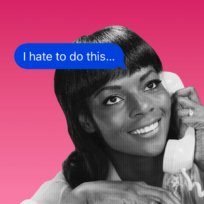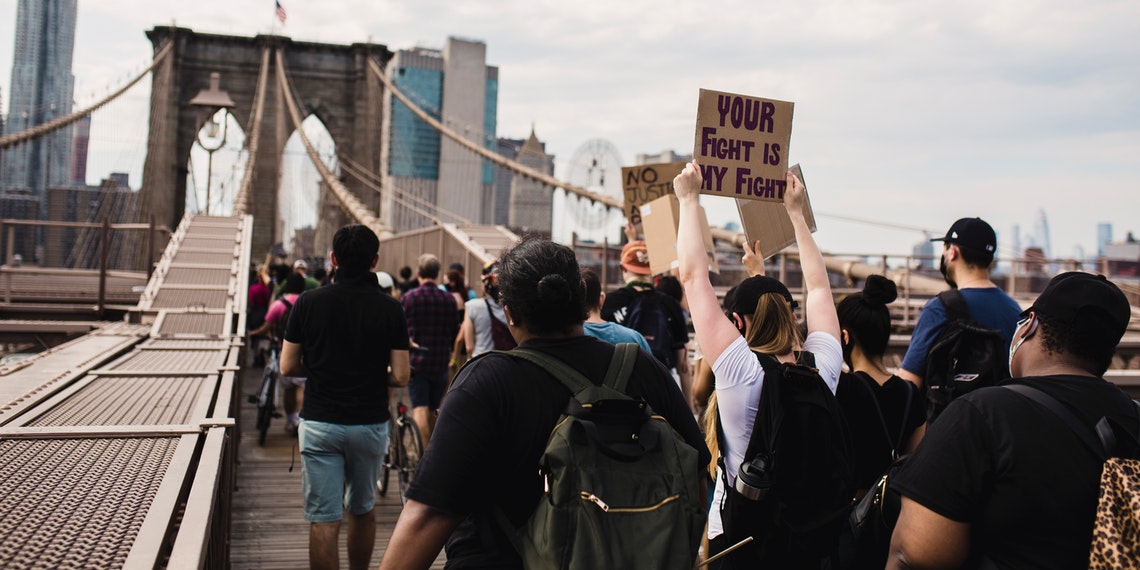After Blackout Tuesday, you may have seen the term “optical allyship” making the rounds on social media, along with the phrase “it’s a movement, not a moment.” While it’s great that Black Lives Matter is finally being accepted in the mainstream and talked about on a global scale, and showing solidarity (especially on social media) is important, it shouldn’t be your only step toward working to be anti-racist. If you are committed to practicing allyship continually, it’s important to learn what optical allyship is, why it’s counterproductive, and how you can make sure you’re going beyond the optics with your support.
So, What is Optical Allyship?
the internal work – interrogating, re-arranging, and re-educating our psyches and hearts – that’s the hard work. that’s the work nobody will hold you accountable for. do that too. do that most.
— kendra (@kendramorous) June 2, 2020
Latham Thomas, author of Own Your Glow, coined the term optical allyship, which she defines as “allyship that only serves at the surface level to platform the ‘ally.’” She explains, “It makes a statement but doesn’t go beneath the surface and is not aimed at breaking away from the systems of power that oppress.” Basically, optical allyship is performative, serving the ally and not really digging deeper into understanding the systems of oppression so they can be dismantled. Optical allyship is mostly talk, when true allyship is about actions. As Roxane Gay explains in her article On Making Black Lives Matter, “The problem with allyship is that good intentions are not enough. Allyship offers a safe haven from harsh realities and the dirty work of creating change. It offers a comfortable distance that can be terribly unproductive.” Separating yourself from optical allyship means not just posting a black square or Martin Luther King Jr. quote and calling it a day, it means taking on the struggle and fight as if it’s your own and committing to doing the work—not just this week, but beyond. That is where the real allyship begins.
Optical Allyship In Action
One of the obvious examples of optical allyship is the influencers who use the protests and Black Lives Matter movement to up their IG aesthetics. While (I hope) we all know right off the bat why it’s wrong to show up to a protest, take one picture, and then bounce, posting a protest thirst trap isn’t the beginning and end of optical allyship.
Odds are that the majority of us have either posted an Instagram story or retweeted an image or statement recently in efforts to spread awareness and show support for the movement. If you are not also donating to causes supporting Black Lives Matter, supporting Black-owned businesses, reading up on Black history, and/or calling your representatives, then that Instagram story or retweet falls under optical allyship. In an Instagram post, Thomas explains, “True allyship is about building trust, being consistent, standing up, speaking up, recognizing the struggle and carrying some of the weight, it’s using your God-given sense to figure some of this stuff out and not waiting for folks to tell you.”
I get it for those of you out there that want to support the movement but aren’t sure how or what to do. I can also see how one might think that posting a black square is a contribution to the cause because you’re showing solidarity, but in reality, ask yourself what is it really doing and who is it really serving? It is not enough to just post a quote or an image without any context or link out to reliable resources. That is when your allyship becomes performative and fails to break through to deeper levels in order to invoke real conversation and change. Really, it’s time to put your money where your black square is. As Roxane Gay puts it, “We need people to use common sense to figure out how to participate in social justice.”
https://www.instagram.com/p/BiPDZkbFJFY/?utm_source=ig_embed
How To Be An Authentic Ally
So, how do you make the leap from optical allyship to being an authentic ally? Well for starters, just listen without feeling the need to insert yourself into the dialogue. As Thomas writes in her Instagram caption, “just because you’re new to the work, doesn’t mean it’s new. Know that folks have been working all along and you’re stepping into something already in play…get in where you fit in, take notes, bring resources, and acknowledge you have work to do.” Especially as white people, one of the best things we can do (and it’s so easy) is actually just shut up and listen.
That doesn’t mean you should never post on social media about Black Lives Matter—it just means be intentional about what you do post. Instead of just posting a square, see if you can post resources. Share organizations, educational materials, and places to donate. Share artwork by BIPOC illustrators and designers to amplify their voices.
Systemic racism wasn’t built in a day, and abolishing it won’t happen in a few weeks, either. Continued ally support is essential in the battle against racism. Black lives matter today, they matter tomorrow, and they will continue to matter long after the protests subside. Being an ally is an ongoing commitment. I understand that this learning and these conversations can be uncomfortable, and change can be too, but when people are losing their lives, then it’s time to get uncomfortable.
Yes, take action by educating yourself. Read books, watch documentaries—do that. Then go a step further by implementing your newfound knowledge into your everyday life, and by having discussions with people in your life about what you learned. This doesn’t mean that you have to blow up and check your conservative aunt with soap opera-level dramatics at every family gathering, but you can still discourage and shut down any racist remarks, and help educate those who make them. Conversations lead to change, so they’re worth having—comfortable or not. Amélie Lamont writes in The Guide To Allyship, “As an ally, you need to be willing to own your mistakes and be proactive in your education.” Not to be cheesy, but every day is a new opportunity to do better. You can also continue your practice by following accounts that reinforce these ideologies, like Mireille Harper, who released a 10-step guide to achieving non-optical allyship. The resources are all there, so use them. Seriously, if you can take the time to learn how to bake sourdough bread, then you can take the time to learn how to be an ally.
How To Make Allyship Your Lifelong Priority
There’s another level of allyship that goes beyond sharing resources, spending money, and having hard conversations with family members and friends. You may have heard the saying, “when you’re accustomed to privilege, equality feels like oppression.” This refers to how the actions that are necessary to truly dismantle systemic racism might appear to mean putting yourself or your white peers at a seeming disadvantage in some parts of your life.
The difference between these types of opportunities for allyship, versus what we’ve been witnessing happening on social media over the past few weeks, is that we don’t always get to choose when these opportunities arise for us, and they may appear as harder choices than simply choosing to buy from a Black-owned brand. But recognizing these opportunities to stand up and speak up, and then doing it, is what makes allyship authentic vs. performative.
For example, let’s say you’re a parent at a school district meeting. Pretend it’s a great school district, the type where parents will pay higher property taxes to give their children the chance to attend. Now pretend that the racial or socioeconomic makeup is one that doesn’t allow for a lot of diversity. Back to the hypothetical school board meeting: the issue at hand is trying to more actively integrate the school district, and that might be coded as “adding more multi-family homes to the district” aka zoning apartments. If you grew up in certain elitist suburbs, you know that there will be individuals who resist these changes, chalking it up to things like “property values” and the “school district ranking.” In this scenario, focusing on these latter things would indicate that someone prioritizes maintaining one’s own advantages (building wealth, premium education for their children) rather than allowing children of color to access these advantages as well. A commitment to being anti-racist can sometimes mean dismantling those types of perceived “disadvantages” for the sake of the greater good.
This is just one of the thousands of examples of systemic racism that persist in our society in ways that white people can choose to ignore and uphold. They’re also not the types of choices that we’re faced with every day, and perhaps these types of choices have previously been consciously uncoupled from race in the minds of most white people. The goal is to be able to see what issues in society have been insidiously shaped by racist policies, so that when we’re presented with an opportunity to actually do something about them, we’ve been educated and are committed enough to make the right choice, even if they might take away some of the advantages we’ve enjoyed in the past.
Images: Life Matters / Pexels; Kendra Austin / Instagram; Off Campus / Instagram; Shana Hezavehi / Instagram



















































